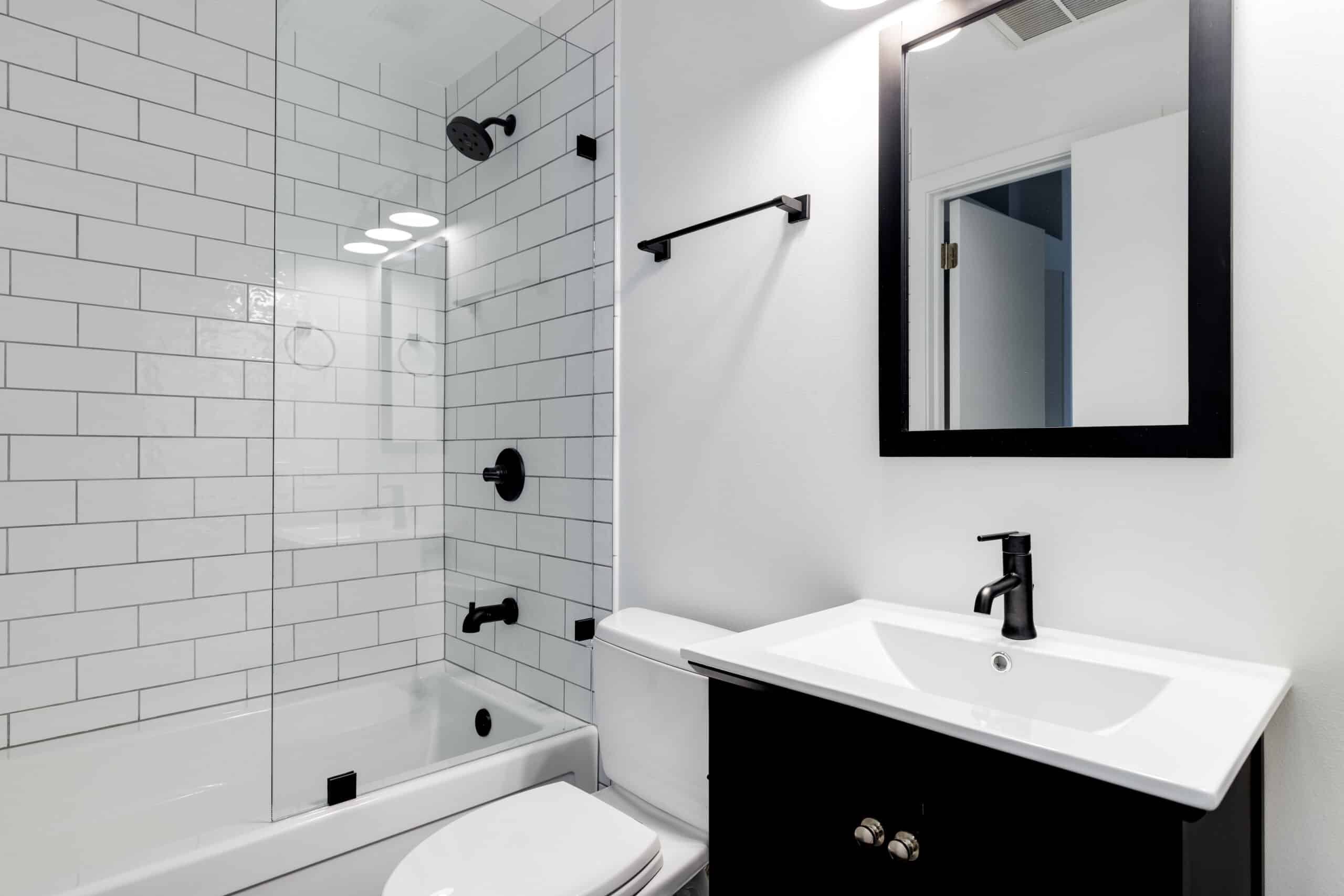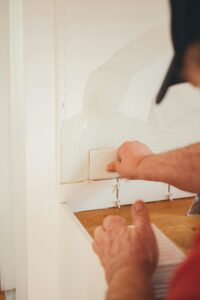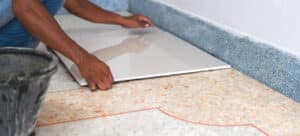Understanding Bathroom Fitting
When planning a renovation or remodel, understanding the ins and outs of bathroom fitting is crucial. This includes understanding what bathroom fitting entails and the importance of hiring a professional to handle the job.
What is Bathroom Fitting?
Bathroom fitting refers to the process of installing or updating the fixtures and amenities in a bathroom, such as the sink, toilet, shower, bathtub, faucets, and cabinets. It can also include the installation of heating and ventilation systems, tiling, and lighting fixtures. Bathroom fitting is a significant aspect of home renovations and remodels, as it can drastically improve the functionality and aesthetic appeal of the bathroom.
Bathroom fitting involves a variety of tasks, including plumbing, electrical work, tiling, plastering, and carpentry. It’s a complex process that requires a high level of skill and expertise, as even minor errors can lead to significant issues down the line. For more information on the subject, refer to our complete guide to professional bathroom fitting services.
The Importance of Professional Bathroom Fitting
While it might be tempting to attempt a DIY bathroom fitting to save on costs, the advantages of hiring a professional bathroom fitter outweigh any potential savings. Professional bathroom fitters have the necessary training, experience, and tools to handle the job efficiently and effectively. They can ensure that all installations meet the required safety standards and function as intended.
Professional bathroom fitters can also provide valuable advice on bathroom design and layout, helping you make the most of your space and achieve your desired aesthetic. By hiring a professional, you can avoid common installation mistakes and ensure a high-quality finish that will stand the test of time. To understand the common mistakes to avoid when choosing a bathroom installer, check out our article on mistakes to avoid when choosing a bathroom installer.
In terms of cost, while hiring a professional may seem more expensive upfront, it can save you money in the long run. Incorrect installations can lead to costly repairs and replacements, not to mention the inconvenience and stress. By investing in professional bathroom fitting, you can ensure a smooth installation process and a bathroom that will serve you well for years to come. For more insights on budgeting for your renovation project, refer to our article on bathroom fitting costs: budgeting for your renovation project.
Breaking Down Costs
One of the most crucial steps in planning your renovation project is understanding the costs involved. Bathroom fitting costs can be divided into three main categories: labor, materials, and miscellaneous expenses.
Labor Costs
Labor typically constitutes the largest portion of your bathroom fitting costs. This includes the charges for professional bathroom installers & fitters who will carry out the necessary work, such as plumbing, electrical wiring, tiling, and installation of fixtures.
Labor costs can vary based on the complexity of the job, the experience level of the workers, and the region in which you live. It’s important to get multiple quotes from different contractors to ensure you’re getting a fair price.
| Labor Type | Cost Range |
|---|---|
| Plumbing | $45 – $200 per hour |
| Electrical | $50 – $100 per hour |
| Tiling | $4 – $14 per square foot |
| Installation | $35 – $85 per hour |
Material Costs
Material costs encompass everything from tiles and fixtures to grout and paint. These costs can fluctuate greatly depending on the quality and style of the materials chosen. For example, marble tiles will be more expensive than ceramic ones, and a high-end faucet will cost more than a basic model.
| Material | Cost Range |
|---|---|
| Tiles | $1 – $50 per square foot |
| Fixtures | $20 – $500+ per item |
| Paint | $15 – $50 per gallon |
| Grout | $5 – $20 per pound |
Miscellaneous Costs
Miscellaneous costs account for any additional expenses that may arise during the project, such as waste disposal, delivery fees, or permit costs. It’s always wise to budget for these unexpected costs to avoid any financial surprises during the renovation process.
| Miscellaneous Cost | Cost Range |
|---|---|
| Waste Disposal | $20 – $60 per ton |
| Delivery Fees | $50 – $100 per delivery |
| Permit Costs | $50 – $200 per permit |
Understanding where your money is going in a renovation project is key to keeping your budget under control. Always request itemized quotes from your contractor to ensure every cost is accounted for. For more tips on budgeting for your bathroom renovation, be sure to check out our article on bathroom fitting: understanding the time and cost involved.
Budgeting for Your Bathroom Fitting Project
When planning a bathroom fitting project, understanding the costs involved is critical. This section will guide you on how to estimate costs and identify common overlooked expenses.
How to Estimate Costs
Estimating bathroom fitting costs involves considering various factors. The primary costs can be divided into labor and material costs.
Labor costs are typically charged per hour or as a flat rate, and these rates can vary significantly based on the contractor’s experience and reputation. Material costs include all the materials required for the project, such as tiles, fixtures, and fittings.
To get a rough estimate of your project costs, you can use the following formula:
Estimated Costs = (Labor Costs x Estimated Hours) + Material Costs + 10% Contingency
Keep in mind that this is a rough estimate and actual costs may vary. You should get detailed quotes from several bathroom installers & fitters to get a more accurate cost estimate.
Common Overlooked Expenses
When budgeting for a bathroom fitting project, there are several commonly overlooked expenses that you should keep in mind:
- Waste Removal: After the installation, there will be waste materials that need disposal. This cost is often not included in initial estimates.
- Unexpected Repairs: If the bathroom is old, there may be unexpected repairs required, such as fixing leaks or replacing old pipes.
- Delivery Fees: Some companies charge for delivering materials to your home.
- Contingency Fund: It’s wise to set aside a contingency fund for any unexpected costs that may arise during the project.
By taking these overlooked expenses into account, you can create a more accurate budget for your bathroom fitting project.
For more helpful insights on bathroom fitting, check out our articles on top tips from expert bathroom fitters: ensuring quality installations and bathroom fitting: understanding the time and cost involved.
Saving on your Bathroom Fitting Project
When it comes to managing your bathroom fitting costs, effective budgeting is key. However, there’s more to budgeting than simply cutting corners. This section will offer tips for cost reduction and discuss how to balance cost with value to make smart choices for your bathroom renovation project.
Tips for Cost Reduction
Reducing costs doesn’t mean you have to compromise on quality. Here are a few tips to help you save on your bathroom fitting project:
- Compare Quotes: Always get multiple quotes from different bathroom installers & fitters. It allows you to get a sense of the average costs and identify the most affordable option without compromising on quality.
- Plan Ahead: A well-planned project can help minimize unexpected costs. Plan your design, materials, and fittings in advance, and stick to that plan to avoid costly last-minute changes.
- Reuse Materials: If possible, consider reusing existing materials. For instance, if your current fixtures are in good condition, refurbishing them could be a cost-effective alternative to buying new ones.
- Buy Materials in Bulk: Purchasing materials in bulk can often lead to significant savings. However, make sure not to overbuy as unused materials could add to your project costs.
- DIY Where Possible: Certain elements of your bathroom fitting project, like painting or simple installations, can be done yourself. However, always hire professionals for complex tasks to avoid costly mistakes. Read more about this in our article on bathroom installation: diy vs. professional fitters.
Value vs. Cost: Making Smart Choices
While it’s important to try and reduce costs, it’s also crucial to consider the value you’re getting for your money. Spending more on quality materials and professional workmanship can save you money in the long run by reducing maintenance and replacement costs.
For instance, investing in a professional bathroom installer might cost more initially, but their expertise can ensure a high-quality finish that lasts for years. Similarly, spending more on durable, water-resistant materials can prevent future damage and save on repair costs.
When budgeting for your bathroom installation, always consider the long-term value. A bathroom renovation is a significant investment, so make sure to spend your money wisely. For more tips on ensuring quality installations, check out our article on top tips from expert bathroom fitters.
Hiring a Contractor for Bathroom Fitting
A significant factor that impacts the success of a bathroom renovation project is the contractor you hire. Choosing the right bathroom installer can make all the difference in ensuring a smooth project that delivers on your vision and stays within budget.
What to Look for in a Contractor
When searching for a bathroom installer, there are key qualities to consider. These include:
- Experience: Look for a contractor with substantial experience in bathroom fitting. They should have a portfolio showcasing their work and a track record of satisfied clients.
- Licenses and Insurance: Ensure the contractor holds all the necessary licenses and insurance to carry out the work legally and safely.
- Transparency: The contractor should provide a clear and detailed quote, explaining all costs involved in the project. This transparency helps avoid misunderstandings and unexpected expenses down the line.
- Communication: Good communication is crucial. The contractor should listen to your needs, provide suggestions, and be available to answer your questions throughout the project.
- References: A reputable contractor should have positive references. Consider reaching out to past clients to learn about their experiences.
For more detailed information on what to look for in a contractor, check out our guide on finding the right bathroom installer.
Questions to Ask a Potential Contractor
When meeting with potential contractors, it’s essential to ask the right questions. This step helps ensure you’re well-informed about what to expect and can make a confident decision. Here are some questions to consider:
- How many years of experience do you have in bathroom fitting?
- Can you provide references from past clients?
- Do you have the necessary licenses and insurance?
- Can you provide a detailed cost breakdown for the project?
- What is the expected timeline for the project?
- How will changes or unforeseen issues be handled?
For an exhaustive list of questions to ask, read our article on essential questions to ask before hiring bathroom fitters.
Hiring the right contractor is a crucial step in your bathroom fitting project. Take the time to do your research, ask the right questions, and make a decision that you feel confident about. This effort will help ensure a successful project that stays within your budget and delivers on your vision for a beautifully renovated bathroom.
Planning Your Bathroom Renovation
When it comes to bathroom fitting costs, budgeting for your renovation project is only part of the equation. Equally important is the creation of a timeline and the management of expectations. This involves understanding potential challenges and coming up with strategies to mitigate them.
Creating a Timeline
A well-thought-out timeline is crucial for any bathroom renovation project. It gives a clear roadmap of the tasks that need to be completed and helps in coordinating with bathroom installers & fitters.
Start by making a list of all the tasks that need to be done, from the initial planning to the final cleanup. Then, estimate the time each task will take. You’ll need to take into account factors such as the size of your bathroom, the complexity of the design, and the availability of the contractors.
Here’s a simple example of what a bathroom renovation timeline might look like.
| Task | Time Estimate |
|---|---|
| Initial Planning | 1-2 weeks |
| Contractor Hiring | 1-2 weeks |
| Material Ordering and Delivery | 2-4 weeks |
| Demolition | 1 week |
| Installation | 2-3 weeks |
| Final Touches and Cleanup | 1 week |
Remember, this timeline is just an example and your specific timeline may vary. For a more detailed guide on creating a timeline for your bathroom renovation, check out our article on maximizing efficiency: streamlining your bathroom installation.
Managing Expectations and Preparing for Challenges
It’s important to enter a bathroom renovation project with realistic expectations. Understand that even with the most meticulous planning, unexpected issues can arise. This could be anything from discovering plumbing issues to delays in material delivery.
To prepare for such challenges, it’s advisable to include some extra time and money in your budget. Experts often recommend adding a contingency of around 10-20% to your overall budget for unforeseen expenses.
For more information about common challenges in bathroom installation and how to overcome them, visit our article on common challenges in bathroom installation and how to overcome them.
Planning in advance and managing expectations can help ensure a smoother bathroom renovation process. By creating a detailed timeline and preparing for potential challenges, you’ll be well on your way towards successfully managing the bathroom fitting costs and completing your renovation project.




